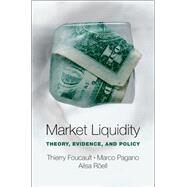- ISBN: 9780199936243 | 0199936242
- Cover: Hardcover
- Copyright: 3/25/2013
The way in which securities are traded is very different from the idealized picture of a frictionless and self-equilibrating market offered by the typical finance textbook. Market Liquidity offers a more accurate and authoritative take on liquidity and price discovery. The authors start from the assumption that not everyone is present at all times simultaneously on the market, and that even the limited number of participants who are have quite diverse information about the security's fundamentals. As a result, the order flow is a complex mix of information and noise, and a consensus price only emerges gradually over time as the trading process evolves and the participants interpret the actions of other traders. Thus a security's actual transaction price may deviate from its fundamental value, as it would be assessed by a fully informed set of investors.
This book takes these deviations seriously, and explains why and how they emerge in the trading process and are eventually eliminated. The authors draw on a vast body of theoretical insights and empirical findings on security price formation that have accumulated in the last thirty years, and have come to form a well-defined field within financial economics known as 'market microstructure.' Focusing on liquidity and price discovery, they analyze the tension between the two, pointing out that when price-relevant information reaches the market through trading pressure rather than through a public announcement, liquidity suffers.
The book also confronts many puzzling phenomena in securities markets and uses the analytical tools and empirical methods of market microstructure to understand them. These include issues such as why liquidity changes over time, why large trades move prices up or down, and why these price changes are subsequently reversed, why we see concentration of securities trading, why some traders willingly disclose their intended trades while others hide them, and why we observe temporary deviations from arbitrage prices.
This book takes these deviations seriously, and explains why and how they emerge in the trading process and are eventually eliminated. The authors draw on a vast body of theoretical insights and empirical findings on security price formation that have accumulated in the last thirty years, and have come to form a well-defined field within financial economics known as 'market microstructure.' Focusing on liquidity and price discovery, they analyze the tension between the two, pointing out that when price-relevant information reaches the market through trading pressure rather than through a public announcement, liquidity suffers.
The book also confronts many puzzling phenomena in securities markets and uses the analytical tools and empirical methods of market microstructure to understand them. These include issues such as why liquidity changes over time, why large trades move prices up or down, and why these price changes are subsequently reversed, why we see concentration of securities trading, why some traders willingly disclose their intended trades while others hide them, and why we observe temporary deviations from arbitrage prices.






